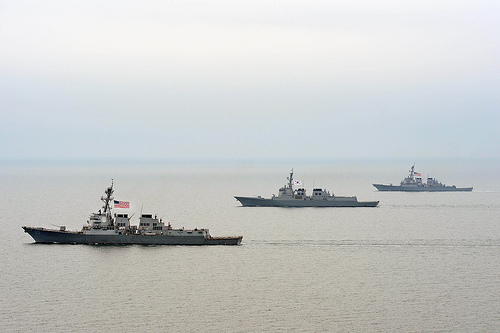
On February 12, North Korea conducted its third nuclear weapons test. The UN tightened existing economic sanctions in response. Since then, the Korean peninsula has become an even more dangerous place than usual. Now that’s saying a lot. There’s no place on earth that, per square mile, contains more soldiers and armaments.
The two Koreas together have about 1.6 million troops, backed by a gargantuan arsenal of tanks, missiles, combat aircraft, warships and submarines. Some 28,000 American troops are stationed in South Korea, roughly 38,000 in Japan. A North-South war would automatically implicate the U.S., both because it has an alliance with Seoul and because the North would immediately target American installations in South Korea and Japan in the opening phase. China, Japan and Russia could be sucked into the maelstrom.
So the threats and counter threats and moves and countermoves we’ve witnessed recently could easily set the stage for a rush from crisis to war. That’s why words and gestures matter.
Here’s what the picture looks like on that front. North Korea has threatened to attack South Korea, the United States and Japan with nuclear weapons, declared the 1953 armistice a dead letter and cut off emergency lines of communication. South Korea has warned the North’s leaders that they would be “wiped off the face of the earth” if they start a war. In the midst of this mess, the U.S.-South Korea “Foal Eagle” military exercises are underway. American B-52s (based in Guam) and, subsequently B-2 stealth bombers, have flown over South Korea. President Obama has moved to beef up U.S. missile defense systems in California and Alaska. Far from inducing Pyongyang to cool down, these moves have led it to ratchet up its rhetoric. Kim has ordered his military brass to prepare for war.
China and Russia warn that, left unchecked, this tit-for-tat dynamic could produce a disaster.
Now these details are indisputable and supported by evidence. But there’s a lot we just don’t know — and won’t. Is the North bluffing? Some pundits say yea, others nay. The truth is that they simply don’t know, as North Korea’s politics are utterly opaque. There are no “experts” on that country, only varying degrees of ignorance; the first reality to face is that we don’t know what the North is thinking or planning. That alone should incline us to tread cautiously.
Surrounded by longtime generals who are old enough to be his grandfather, it’s reasonable to assume that young Kim doesn’t wish to appear weak in his first big global test — which means he can’t tone down the threats or, should a skirmish occur, back down. That’s bad news.
Yet it’s inconceivable that the North actually wants war. Why? Because, troops aside, the South has a huge advantage over the North in key measures of strength: GDP, defense spending and the age and technological sophistication of major armaments, to mention a few. Then there’s Seoul’s alliance with the world’s most powerful country. Yes, the North has nuclear weapons, but the U.S. has many, many more. Kim’s generals can have no illusions about what would happen if they start a nuclear war: North Korea would be utterly destroyed.
So can we rest easy, assuming that rationality will win out? Not in the least. It’s during crises like these that what psychologists call cognitive dissonance kicks in big time. Under stress, adversaries cling to existing stereotypes, underestimate each other’s resolve and strength, overlook evidence that disconfirms existing beliefs, think in terms of worst-case scenarios and expect that things will got their way. After the North Koreans cuts off the hotlines, they said that the systems were not needed now that war was on the horizon. Precisely the opposite is true. They’re needed now more than ever to manage the fallout from a single incident that might set off a dangerous spiral.
My bet? This crisis will pass after some more yelling and strutting, but I can’t say that for sure. Nor can anyone else. What’s certain is that a war on the Korean peninsula would kill tens of thousands of people. It would also spread to other countries, with consequences we cannot now imagine. That’s why a single statement or a one-off action that one side initiates to play to the galleries at home, to show that it won’t be cowed, or (in the case of the United States) to reassure allies, could be the spark that lights the fire. To paraphrase Ralph Waldo Emerson, then events will be in the saddle, riding leaders.
The United States and South Korea have vast military resources on site already, for deterrence and, heaven forbid, war fighting. There’s no added value in saying or doing more. That will merely heat up this crisis, contribute to cognitive dissonance and allow a single incident (a ship that’s sunk, a soldier who’s shot) to take us to a place that no one wants to go — not Pyongyang, not Seoul, not Washington. Sometimes less is more.
Rajan Menon is the Anne and Bernard Spitzer Professor of Political Science at the City College of New York/City University of New York, nonresident senior fellow at the Atlantic Council and the author, most recently, of The End of Alliances. This piece first appeared on Real Clear World.
Photo credit: US Navy/Mass Communication Specialist 3rd Class Declan Barnes
Image: 8576750699_6dbc18f382.jpg
